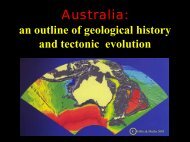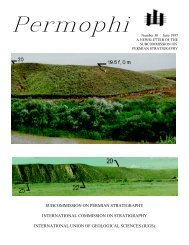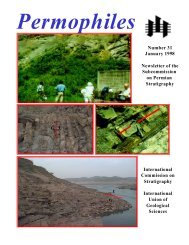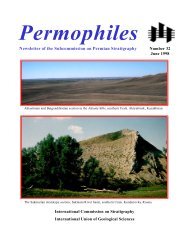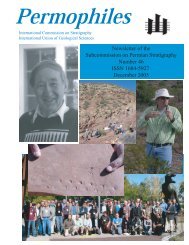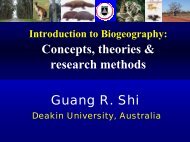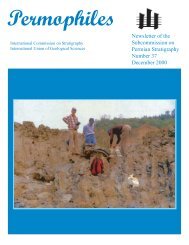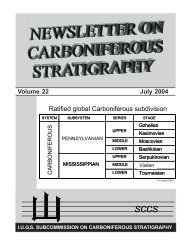Permophiles
Permophiles
Permophiles
You also want an ePaper? Increase the reach of your titles
YUMPU automatically turns print PDFs into web optimized ePapers that Google loves.
succession, the upper part of the Laibin Limestone consists ofhigh frequency cycles. Both Bed 6i-lower and Bed 6k form theupper parts of the uppermost two cycles and are fairly gradationaland continuous with the lower parts of each cycle.Though depositional gaps might occur between cycles, theyseem no more than those at normal bedding planes; that is, theyare insignificant in terms of the resolution of conodontchronostratigraphy. A conodont zone usually comprises manycycles.Some colleagues consider that only such rapid change offossils and rocks permits worldwide correlation and recognitionof beds of a defined age. Others indicate that the rapid faunaland sedimentological changes reflect an incomplete geologicalrecord; this view would require a boundary definition based onsubtle stratigraphic changes that may not be useful for subsequentcorrelation.Option B.A point defined by the FAD at the base of Bed 6kof Clarkina postbitteri postbitteri within an evolutionarylineage from C. postbitteri hongshuiensis subsp. nov. to C.dukouensis. The FAD of C. postbitteri sensu lato could also beused to approximate this boundary, as it is only 20 cm below thedefining point at the base of Bed 6i-upper at the PenglaitanSection. The reason for taking the name Clarkina postbitteripostbitteri is that the holotype of C. postbitteri postbitteri isfrom Bed 6k, of which the main part was originally marked as Bed115 and the transitional part between Bed 115 and 114, as Bed114.6.Clarkina postbitteri postbitteri is a transitional formbetween C. postbitteri hongshuiensis and C. dukouensis.Therefore, the FAD of C. postbitteri postbitteri is defined withina gradational lineage in which deposition is continuous.The main questions regarding this option are as follows.First, it may not be possible to consistently demonstrate theexact point at which Clarkina postbitteri hongshuiensisbecomes C. postbitteri postbitteri, although it is fairly clear atPenglaitan. An arbitrary point in a morphologic transition isexactly that, arbitrary, and almost certainly inconsistent.Second, this level does not correspond exactly to any majorevent in global biological or environmental change, and thus,this fossil zone alone is not sufficient for inter-regional correlationof the Guadalupian-Lopingian boundary sequences if we areto satisfy both of the requirements for depositional completenessand correlation potential. With that in mind, “priority can begiven to the level with the best correlation potential” (Guidelineof the ICS, 1996) and a compromise solution between these tworequirements for the candidate section must be found. Ourmembers need reliable information from various sources,including especially from the conodont workers, in order to makethe right decision. In addition, a flexible mind and some concessionsin selection of the GSSP are necessary in order that thisarbitrary reference point can gain a majority of votes.Decision of the International Working Group on the LopingianSeries<strong>Permophiles</strong> Issue #39 200139Figure 6. A sketch ofthe Penglaitan section inLiabin, Guangxi, China,showing the options forthe potential GSSP ofthe Guadalupian-Lopinigan boundary.The Lopingian Boundary Working Group consists of YuganJin, Brian Glenister, Bruce Wardlaw, Charles Henderson, ChengyuanWang, Claude Spinosa, Douglas Erwin, Ernst Leven, GalinaKotlyar, Guangrong Shi, Heinz Kozur, Jinzhang Sheng, ZhuotingLiao, Shilong Mei, Shuzhong Shen, Tatyana Leonova, VladimirDavydov, Xiangdong Wang, and Yukio Isozaki. An informal surveywas conducted on the following four choices: 1. Both optionsare acceptable, 2. Option A is preferred, 3. Option B is preferred, 4.Neither option is acceptable. Among the 18 members of the workinggroup who have replied, eight members prefer Option A, sevenprefer Option B, two remain noncommittal until the index conodonttaxa at the boundary levels are officially published, and eight feelboth options are acceptable but seven of them have their ownpreferences between the two. If we add up the numbers of memberswho support choices (1) and (2), Option A gets support from12 members. Likewise, if we add up the numbers of members whosupport choices (1) and (3), Option B also gets support from 12members.Although the survey shows a unanimous agreement on supportingthe Penglaitan Section as the stratotype section, neitherof the two potential boundary levels has gained a required majorityof support. As a result, the selection of the boundary level hasnow become a tie. In order to break the tie and to reach a timelyconsensus, the authors would like to ask the members to supportOption B, even though it may not be ideal or necessarily betterthan Option A. Our rationale is that the stratotype point is arbitraryand conventional, and thus its selection ought to be practicalas well as principled. In practice, correlation of this Guadalupian-Lopingian boundary will be achieved by using a set of drasticfaunal and physical changes and need not rely only on the mor-



